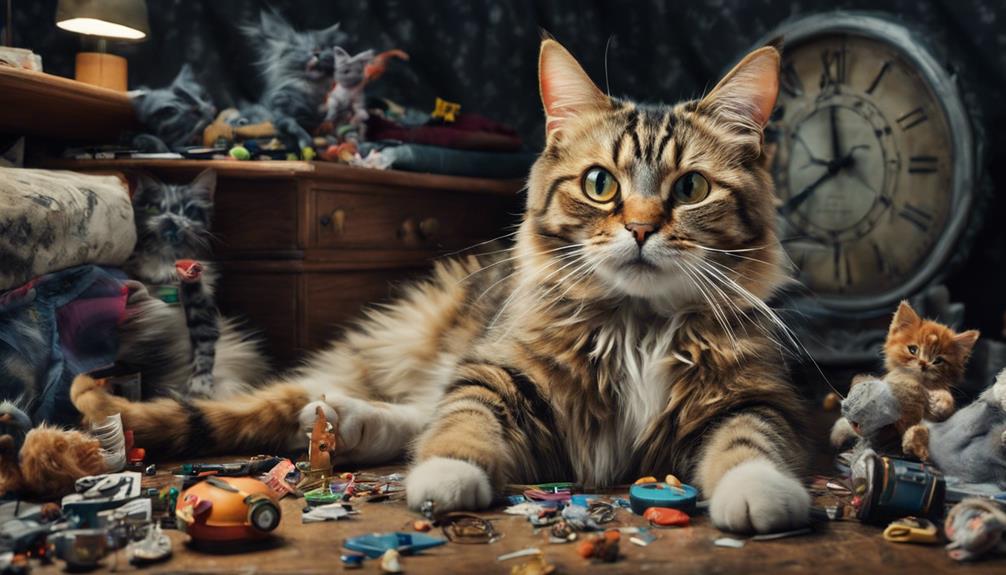Understanding the potential harm toxic ferns can pose to cats is crucial for safeguarding the well-being of our feline friends. While the Boston fern is typically harmless, toxic varieties like the asparagus fern can cause issues such as vomiting , diarrhea , and general discomfort in cats. Symptoms may also manifest as stomach pain, drooling, and skin irritation . It is imperative to seek immediate veterinary attention if poisoning is suspected. To prevent any negative effects, keep toxic ferns out of pets’ reach and opt for cat-friendly plants instead. Early recognition of symptoms and swift action can greatly impact the health and happiness of our cats. For additional information on fern toxicity and cat safety, concerned pet owners can refer to resources available to ensure their beloved companions stay healthy and content.
Key Takeaways
- Boston fern is safe; avoid toxic ferns like asparagus fern.
- Symptoms include vomiting, diarrhea, stomach pain, drooling.
- Immediate vet care needed for toxic fern ingestion.
- Prevent access to toxic ferns; provide safe alternatives.
- Early recognition crucial to prevent complications.
Fern Toxicity in Cats
Fern toxicity in cats can vary depending on the type of fern they ingest. While true ferns like the Boston fern are generally safe for our feline friends, toxic ferns such as the asparagus fern can lead to unpleasant symptoms like vomiting and diarrhea in cats. These symptoms may also include stomach pain, drooling, and skin inflammation. It's vital to remember that if a cat ingests a toxic fern, immediate veterinary care is necessary to guarantee their well-being.
To protect our beloved cats from fern toxicity, it's important to prevent their access to toxic ferns and provide safe alternatives for them to explore. By being mindful of the plants in our homes and surroundings, we can create a safer environment for our furry companions. Remember, a little precaution goes a long way in keeping our cats healthy and happy.
Signs of Fern Poisoning in Cats

When cats ingest toxic ferns, they may experience symptoms like vomiting, diarrhea, and stomach pain. These signs of fern poisoning can also include drooling, skin inflammation, and discomfort.
It's important for owners to recognize these symptoms early and seek immediate veterinary care to prevent any further complications.
Common Toxicity Symptoms
Recognizing the common signs of fern poisoning in cats is vital for prompt veterinary intervention and successful recovery. Vomiting, diarrhea, stomach pain, drooling, and skin inflammation are typical symptoms that may indicate fern toxicity in our feline friends.
If you notice your cat exhibiting any of these signs after potential exposure to toxic ferns, seeking immediate veterinary care is imperative. Ingesting harmful ferns can lead to gastrointestinal upset and skin irritation in cats, necessitating professional attention to guarantee their well-being.
Some toxic fern varieties can even cause more severe symptoms like organ damage, underscoring the importance of early detection and treatment. By staying vigilant and recognizing these common toxicity symptoms, we can help our beloved cats receive the care they need to recover swiftly.
Treatment Options Available
If a cat shows symptoms of fern poisoning, immediate veterinary consultation is crucial to ensure appropriate treatment and care. When dealing with fern toxicity in cats, here are some common treatment options available:
- Veterinary Consultation: Seek immediate professional advice to determine the best course of action for your cat's specific situation.
- Rinsing and Cleaning: Veterinarians may rinse your cat's skin or mouth to remove any remaining fern residue.
- IV Fluids: In severe cases, IV fluids might be necessary to help your cat recover from dehydration or other complications.
- Topical Creams: To soothe skin irritation caused by fern ingestion, topical creams can be applied as part of the treatment plan.
Prevention Tips for Owners
To protect our feline companions from fern poisoning, owners must be vigilant in recognizing the signs of toxicity and implementing preventive measures. Cats may show symptoms like vomiting, diarrhea, stomach pain, drooling, and skin inflammation if they ingest toxic ferns. Immediate veterinary care is essential if poisoning is suspected. Bringing a sample of the plant ingested can assist in diagnosis and treatment. Preventative actions such as keeping ferns out of reach and opting for cat-friendly plants can help avoid toxicity. Here's a table to highlight some prevention tips:
| Prevention Tips | Description | Importance |
|---|---|---|
| Keep ferns out of reach | Prevents cats from accessing toxic plants | Vital to avoid ingestion |
| Use cat-friendly plants | Provides safe alternatives for indoor greenery | Guarantees a pet-safe environment |
| Watch for skin irritation | Check for any signs of skin inflammation after contact | Early detection of potential toxicity symptoms |
Symptoms of Fern Toxicity

Experiencing symptoms of fern toxicity in cats can be alarming and require immediate attention from a veterinarian. If your feline friend has ingested toxic ferns, here are some signs to watch out for:
- Vomiting: One of the most common symptoms of fern toxicity in cats is vomiting. If you notice your cat throwing up frequently, especially after being around ferns, it could indicate a problem.
- Diarrhea: Cats may also experience diarrhea as a result of ingesting toxic ferns. Keep an eye on your cat's litter box habits for any changes in stool consistency.
- Stomach Pain: Cats might exhibit signs of stomach discomfort such as restlessness, vocalization, or sensitivity when their belly is touched.
- Drooling and Skin Inflammation: Excessive drooling and skin irritation are additional indicators of fern toxicity in cats. If you notice your cat drooling more than usual or showing signs of skin inflammation, veterinary care promptly.
Ferns and Cat Health Risks

True ferns like Boston fern and Sword fern are generally important for cats to ingest, but toxic ferns such as Asparagus fern and Foxtail fern can pose health risks if consumed.
It's vital to be aware of fern toxicity to protect our feline friends. Symptoms of poisoning from toxic ferns in cats may include vomiting, diarrhea, stomach pain, drooling, and skin inflammation. If you suspect your cat has ingested a toxic fern, seeking immediate veterinary care is essential to prevent severe complications.
By taking preventive measures like keeping toxic ferns out of reach and offering cat-friendly alternatives, we can safeguard our cats from fern toxicity.
Being mindful of the ferns we've in our homes and gardens can go a long way in ensuring the well-being of our beloved companions. Remember, a little precaution can go a long way in keeping our cats safe and healthy.
Cat Reactions to Ferns

Ferns can trigger mild symptoms in cats if consumed, such as stomach upset. Some fern species can be toxic to cats, causing gastrointestinal distress like vomiting and diarrhea.
It's important to be aware of the potential reactions cats may have to ferns to guarantee their safety and prompt medical attention if needed.
Ferns and Cat Safety
Upon encountering ferns, cats may exhibit various reactions based on their texture and taste preferences.
- Cats are often drawn to the lush, leafy appearance of ferns, leading them to explore and potentially ingest these plants.
- True ferns are generally safe for cats to nibble on, but it's essential to make sure they aren't consuming any toxic varieties.
- Ingesting ferns can result in mild symptoms like an upset stomach, causing vomiting and diarrhea in cats.
- However, if a cat ingests a toxic fern species, immediate veterinary attention is necessary to prevent severe health issues.
It's important to keep a close eye on your feline friend around ferns to guarantee their safety and well-being.
Toxic Fern Species
When encountering toxic fern species, cats may exhibit adverse reactions such as vomiting, diarrhea, stomach pain, and drooling. It's important to be aware of fern varieties like asparagus fern, foxtail fern, winter fern, and hemlock fern, which can pose a threat to our feline friends.
If your cat shows symptoms after potential exposure to these toxic ferns, such as skin inflammation or gastrointestinal distress, seeking immediate veterinary care is essential. Veterinarians can provide the necessary treatment to alleviate your cat's discomfort and prevent more severe complications.
Symptoms of Fern Poisoning
Experiencing symptoms of fern poisoning in cats can be alarming, prompting immediate action to safeguard their well-being. If your feline friend has come into contact with toxic ferns, watch out for the following signs:
- Vomiting or Diarrhea: Cats may exhibit gastrointestinal upset, leading to frequent vomiting or diarrhea.
- Skin Irritation: Look for any signs of skin inflammation or irritation, which could indicate exposure to toxic ferns.
- Gastrointestinal Upset: Your cat might experience stomach pain, drooling, or general discomfort in the abdominal area.
- Lethargy and Loss of Appetite: Keep an eye out for lethargy, decreased activity levels, and a sudden loss of appetite, as these could be indications of fern poisoning.
Fern Palm Poisoning Effects

Fern palm poisoning effects can range from liver failure to central nervous system issues in cats. These toxic plants, such as cycads or sago palms, contain harmful components like cycasin and B-methylamino-l-alanine that wreak havoc on our feline friends. When a cat ingests these plants, it can lead to severe consequences that require prompt attention to prevent further harm. To help you understand the potential effects of fern palm poisoning, we've created a table summarizing the key points:
| Effects of Fern Palm Poisoning in Cats |
|---|
| Liver Failure |
| Central Nervous System Issues |
| Gastrointestinal Distress |
| Seizures |
| Coma |
Fern Toxicity Treatment for Cats

Administering appropriate treatment promptly is essential in addressing fern toxicity in cats. If your feline friend has ingested a toxic plant like a fern, here are some steps that may be taken to help them recover:
- Inducing vomiting: This can help expel any remaining plant material from the stomach, reducing the amount of toxins absorbed.
- Intravenous fluids: Administering fluids can aid in flushing out toxins, preventing dehydration, and supporting the overall recovery process.
- Antihistamines: These medications can be useful in managing any allergic reactions that might result from the ingestion of ferns, providing relief to your cat.
- Gastroprotective medications: Prescribed to alleviate stomach irritation and discomfort, these medications can help your cat feel more comfortable during the recovery period.
Cat Recovery From Fern Poisoning

Recovery from fern poisoning in cats hinges on prompt veterinary care to address symptoms effectively. The importance of monitoring and follow-up care can't be overemphasized to guarantee a successful recovery.
Preventing future incidents involves discouraging cats from ingesting toxic ferns and strategically placing indoor plants out of reach.
Symptoms During Recovery
Throughout the recovery process from fern poisoning, cats may continue to display symptoms such as gastrointestinal distress and skin irritation. Here are some common experiences you might notice as your feline friend recuperates:
- Persistent Vomiting: Your cat may still experience bouts of vomiting as their system works to expel the toxins ingested from the ferns.
- Skin Sensitivity: Skin inflammation and irritation could linger, causing discomfort for your pet during the recovery phase.
- Lethargy: Your cat might seem more tired or less active than usual as they recover from the effects of fern toxicity.
- Decreased Appetite: A temporary loss of appetite is common during recovery, but it should improve as your cat starts feeling better.
Vet Care Importance
Immediate veterinary care plays an important role in helping cats recover from fern poisoning. When a cat ingests toxic plants like ferns, quick action by a vet can be life-saving. Veterinary intervention may include inducing vomiting to remove the toxins and administering activated charcoal to prevent further absorption. Monitoring the cat closely post-treatment is pivotal for a successful recovery. In most cases, the prognosis after receiving proper care is positive. To prevent future incidents, it is imperative to discourage cats from consuming toxic ferns and consider keeping them indoors where they can't access harmful plants.
| Vet Care Importance | Ferns are Toxic | Toxic Plants |
|---|---|---|
| Critical for recovery | Harmful to cats | Must be avoided |
Preventing Fern Toxicity in Cats

To safeguard your feline companion from fern toxicity, it's crucial to keep ferns out of their reach to prevent accidental ingestion. Here are some practical tips to help keep your cat safe:
- Utilize hanging planters or high shelves: By elevating your ferns, you can prevent your inquisitive cat from getting too close to these toxic plants.
- Monitor outdoor access: If your cat enjoys the outdoors, make sure they don't have access to any toxic ferns in the garden or surrounding areas.
- Refer to ASPCA's safe plant list: Establish a cat-friendly environment by selecting plants that are non-toxic to cats. This way, you can create a secure space for your furry friend to explore.
- Educate yourself on toxicity signs: Familiarize yourself with the symptoms of fern toxicity in cats so that you can act promptly if ingestion occurs.
Cat-Friendly Plant Alternatives

When considering cat-friendly plant alternatives, various non-toxic options like Maidenhair Fern, Boston Fern, and Spider Plant provide safe and enriching greenery choices for your feline friend. These plants not only add a touch of nature to your space but also offer a safe environment for your curious cat to explore. Boston Fern, known for its lush and feathery fronds, can thrive both indoors and outdoors, making it a versatile choice. The Spider Plant, with its long, arching leaves, isn't only safe for your cat but also easy to care for, making it a perfect addition to your home.
If you're looking to provide your cat with some extra stimulation, consider incorporating Catnip into your plant collection. Catnip is a herb that many cats find irresistible, offering them a source of entertainment and enrichment. By choosing cat-friendly plants like Boston Fern, Spider Plant, and Catnip, you can create a safe and engaging environment for your beloved feline companion.
Identifying Toxic Fern Varieties

Considering the safety of our feline companions, it's important to be able to identify toxic fern varieties that pose a risk to cats. When it comes to keeping our beloved cats safe from potentially harmful plants like ferns, here are some key points to remember:
- Know the Culprits: Asparagus fern, foxtail fern, winter fern, and hemlock fern are among the toxic fern varieties that can be dangerous for your cat to ingest.
- Recognize Symptoms: Watch out for signs such as drooling, abdominal pain, difficulty breathing, vomiting, diarrhea, and stomach pain in your cat, which may indicate ingestion of toxic ferns.
- Seek Veterinary Care: If you suspect that your cat has consumed a toxic fern, it's essential to seek immediate veterinary care. Prompt treatment can help prevent severe complications and safeguard your cat's well-being.
- Stay Vigilant: Keep a close eye on your cat's behavior and surroundings to prevent accidental ingestion of toxic ferns, and always have the contact information for your veterinarian readily available in case of emergencies.
Toxicity Risks of Common Ferns

Identifying the toxicity risks of common ferns is essential for safeguarding our cats' well-being. While true ferns like Boston fern are generally safe for cats in small amounts, toxic ferns such as the asparagus fern can pose serious risks.
If a cat ingests toxic ferns, symptoms of fern poisoning may include vomiting, diarrhea, stomach pain, drooling, and skin inflammation. It's vital to seek immediate veterinary care if you suspect your cat has consumed a toxic fern like the asparagus fern to guarantee prompt treatment.
To protect our feline friends, it's important to prevent their access to toxic ferns and opt for safer alternatives like the Boston fern. By being aware of the difference between safe and toxic fern varieties, we can create a cat-friendly environment that minimizes the risks of fern poisoning.
Cat Safety Around Ferns

Ensuring the safety of our cats around ferns is paramount for their well-being and health. When it comes to keeping our furry friends safe from potentially toxic plants, here are a few tips to keep in mind:
- Choose safe ferns: Opt for non-toxic fern varieties like Boston fern and Sword fern to create a cat-friendly environment in your home.
- Recognize symptoms: Be vigilant for signs of fern poisoning in cats, such as vomiting, diarrhea, stomach pain, drooling, and skin inflammation, and seek immediate veterinary attention if you notice any of these symptoms.
- Place ferns out of reach: Keep ferns in hanging planters or on high shelves to prevent curious cats from accessing them and potentially getting sick.
- Provide alternatives: Offer pet-friendly alternatives like cat grass and catnip to satisfy your cat's natural urge to chew on plants and help deter them from exploring toxic ferns.
Managing Fern Exposure in Cats

When it comes to managing fern exposure in cats, it's important to be aware of fern toxicity symptoms and the necessary treatment for fern poisoning.
Keeping toxic plants out of reach and offering safe alternatives like cat grass can greatly help in safeguarding your feline friends.
Monitoring your cats for any signs of fern poisoning and acting promptly can make a significant difference in their recovery and overall well-being.
Fern Toxicity Symptoms
Experiencing symptoms of fern toxicity in cats can be alarming, requiring prompt action to manage fern exposure effectively. If your feline friend ingests a toxic fern, watch out for the following signs:
- Vomiting: Cats may vomit frequently after consuming toxic ferns, a clear indication of toxicity.
- Diarrhea: Digestive upset such as diarrhea can occur, leading to dehydration and discomfort.
- Stomach Pain: Cats may exhibit signs of abdominal discomfort, such as restlessness or vocalization due to pain.
- IV Fluids: In severe cases where dehydration is a concern, veterinary intervention with IV fluids may be necessary to restore hydration levels.
Being vigilant for these symptoms and seeking immediate veterinary care can help mitigate the effects of fern toxicity on your beloved pet.
Treatment for Fern Poisoning
In managing fern exposure in cats, prompt veterinary care is vital to address potential toxicity issues effectively.
If your cat has ingested ferns, inducing vomiting may be necessary to remove the plant material from their stomach. Administering activated charcoal can help absorb toxins and prevent their absorption in the gastrointestinal tract.
Additionally, intravenous fluids might be required to prevent dehydration and assist in eliminating toxins from the body. In some cases, antihistamines can help manage allergic reactions or skin inflammation due to fern exposure in cats.
Ferns and Feline Health Concerns

Ferns pose a potential health risk to cats, especially when certain toxic varieties are present in the environment. Here are some essential points to keep in mind:
- Know the toxic ferns: Be aware of plants like Asparagus fern and Foxtail fern, which can be harmful if ingested by your feline friend.
- Recognize the signs: Watch out for symptoms of fern poisoning in cats, such as vomiting, diarrhea, stomach pain, drooling, and skin inflammation.
- Seek immediate help: If you suspect your cat has ingested a toxic fern like Asparagus fern, don't hesitate to seek veterinary care promptly.
- Preventive measures: Keep ferns out of your cat's reach and consider opting for pet-friendly alternatives to help safeguard your furry companion's well-being.
Frequently Asked Questions
What Happens if a Cat Eats a Fern?
If a cat eats a fern, it can lead to gastrointestinal upset with symptoms like vomiting, diarrhea, and stomach pain. Immediate vet care is essential to prevent severe issues. Avoid toxic ferns; opt for safe plants like cat grass.
What Fern Is Not Toxic to Cats?
We appreciate how non-harmful true ferns like Boston fern or sword fern are safe for our feline friends. These plants can add beauty to our cat-friendly home without posing danger. It's important to know the right ferns for our purrfect companions.
What Are the Signs and Symptoms of Plant Poisoning in Cats?
When cats ingest toxic plants, they may experience vomiting, diarrhea, stomach pain, drooling, and skin inflammation. Immediate veterinary care is essential to prevent severe complications like lethargy, loss of appetite, and organ damage.
Which Ferns Are Not Toxic?
We've found that ferns like Boston, Sword, Button, Mother, and Carrot are safe for cats. These non-toxic ferns won't harm feline friends. It's a relief knowing our greenery won't pose risks. Check sources like ASPCA for plant safety.
Are Ferns Toxic to Cats Like Green Onions?
Yes, green onion and cat toxicity are a concern. While ferns are not as toxic to cats as green onions, they can still cause vomiting and diarrhea if ingested. It’s best to keep ferns and green onions out of reach to ensure your cat’s safety.
Conclusion
To sum up, it's important to be aware of the potential toxicity of ferns to cats. Did you know that over 700 species of ferns exist worldwide, with some posing risks to our feline friends?
By understanding the signs, symptoms, and common ferns that can be harmful to cats, we can take steps to keep our pets safe and healthy. Stay informed and proactive to guarantee a safe environment for your beloved cat.










